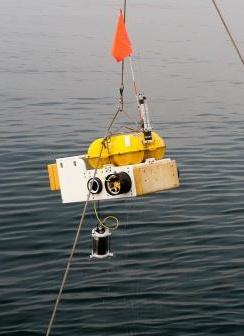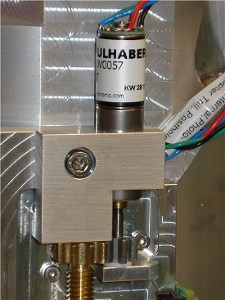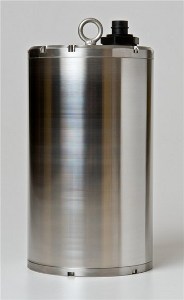 |
| August 20, 2013 | Volume 09 Issue 31 |
Designfax weekly eMagazine
Archives
Partners
Manufacturing Center
Product Spotlight
Modern Applications News
Metalworking Ideas For
Today's Job Shops
Tooling and Production
Strategies for large
metalworking plants
Deep-sea plunge:
Motors level ocean-bottom seismometers reliably and efficiently

To deploy the Trillium OBS (black cylinder), users attach the seismometer to a metal sled that carries it down to the sea floor. At the end of the experiment, the transponder signal triggers the release of ballast and the instrument floats to the surface. [Image courtesy: Nanometrics Inc.]
With a combination of high torque density and precision motion, compact stepper motors provide a full 360 degrees of correction for instrument tilt.
Geophysicists depend on seismometers to monitor earthquakes generated by the motion of the tectonic plates that form the Earth's crust. In order to function, the instruments need to be leveled prior to operation. That's easy enough for a device deployed on dry land, but when it comes to seismometers placed on the ocean floor thousands of feet below the surface, the process gets a bit more challenging. To solve it, Nanometrics Inc. (Kanata, Ontario) combines sophisticated gimbals and microprocessors, along with ultra-reliable, efficient motors from MICROMO (Clearwater, FL).
At its simplest, a seismometer consists of a frame that moves with the underlying rock, a pendulum that essentially acts as an inertial mass, and electronics that track the displacement between the two. Nanometrics seismometers feature three inertial masses aligned on orthogonal axes to allow the instruments to measure in three dimensions.
The frequencies of interest to geophysicists extend from 100 Hz all the way down to below 1 mHz. A classical pendulum consisting of a weight hanging on a string always centers itself thanks to gravity, but it is not suitable for measuring ground motion at very low frequencies. Broadband seismometers typically use some form of inverted pendulum instead, in which a spring, rather than gravity, provides the restoring force. Inverted pendulums aren't self-centering; they need to be balanced. Hence, the need for leveling.
Ocean-floor seismometers operate several kilometers below the surface, far deeper than practical for cables. Instead, the battery-powered instruments operate in isolation for the duration of an experiment, which can last as long as a year. After, they're brought back to the lab for analysis -- and only then do users know whether they worked. "That can be long after they're deployed," says Jeff Potter, director of marketing at Nanometrics. "The ships that deploy and retrieve ocean-bottom seismometers are very costly, so you need to be absolutely sure the sensor will perform perfectly every time."
Reliability is only the start of the requirements. Researchers place ocean-bottom seismometers by attaching them to a weighted sled and letting them sink to the ocean floor, a process that can take hours. At the bottom, they land on an arbitrary, often muddy surface with unknown local topography, and the leveling process begins. In the case of seismometers on dry land, the installer can ensure that the instrument is physically level, but the system may require periodic adjustments to compensate for thermal cycling. For undersea applications, conditions tend to be thermally stable, but mechanical tilt can be both extreme and dynamic. As a result, the mechanical leveling system needs to be able to right the sensors even when the instrument comes to rest upside down.
The three axes of the Trillium Compact OBS (seafloor) and Compact All-Terrain (dry land) are rigidly attached to each other so that the system levels the platform as a whole. To provide a broad range of adjustment, Nanometrics mounts the seismometer in a motorized gimbal. The inner frame rotates the instrument around its own axis, then the outer frame rotates the instrument with respect to the case. Accelerometers on the seismometer and case determine the degree of tilt, then the microprocessor commands the motors to adjust the position as required, fully leveling the system in 20 min. or less.

The leveling mechanism integrates a high-torque-density stepper motor and a gearbox to adjust the position of the instrument. [Image courtesy: Nanometrics Inc.]
The positioning mechanisms need torque in order to level the instrument payload. Normally, the easiest way to increase torque is to choose a larger motor or add a reduction ratio with a gearmotor. The problem the engineering team faced was that the design was space constrained, so simply choosing a larger motor wasn't an option.
"If we'd gone from a 10-mm-diameter motor to a 15-mm motor, the instrument immediately would have gotten a couple of centimeters bigger in diameter," says Nick Ackerley, a senior scientist at Nanometrics.
A larger instrument would require a larger sled in order to carry the device to the seafloor, increasing weight and costs, as well as dimension.
"The ramifications go all the way up to the size of the boat that you're using for your weeks-long cruise out at sea, and these boats can cost hundreds of thousands of dollars a day to book," says Ackerley. "[A small change in motor size] can make the difference between deploying 10 or 15 instruments on a given cruise." The team needed rugged, reliable, compact motors with high torque density, and MICROMO provided the solution.
The design incorporates two stepper motors controlled by a microprocessor. The leveling algorithm uses the accelerometer readings to calculate the motor motions needed to level, but the final leveling result is checked using the seismometers themselves. Using a stepper motor for the motion task brings an important benefit of dependability.
"It makes the control a lot easier to simply be able to command the instrument to a certain location," says Ackerley. "We always check to make sure that the motor actually goes to the position we've ordered. Our algorithms are designed to deal with it if it doesn't, but we've never seen it actually do anything but go to the position that is commanded."

Ocean-floor seismometers like the Trillium OBS must be both rugged and reliable. [Image courtesy: Nanometrics Inc.]
The design transfers motion from the motor to the gimbaled seismometer using a worm gear, which yields a more compact, robust design. The gear also offers stability, even under exposure to shock and vibration. Worm gears cannot be back-driven, for example, which protects the gearbox load. Next, the design team needed to integrate the worm gear with the gearhead. One obvious method was to tie the two together with a set screw, but the motor shaft is just 2 mm in diameter.
"Fastening the gear to the shaft using a set screw was not sufficiently reliable, especially given the very small screw that would have to be used," says Ackerley. "We worked with MICROMO to develop a way to weld a gear directly onto the gearbox output shaft."
Receiving motors with a gear already integrated speeds and simplifies the assembly process for Nanometrics.
The company's Trillium 120 and 240 models for dry-land operation also feature motorized levelers, but rather than positioning the platform as a whole, the motors adjust each pendulum individually. Using bubble levels, the installer can manually position the seismometer to within a few tenths of a degree of level. The additional leveling accuracy provided by the motors means the electronics aren't working as hard to center the masses. This allows the instrument to measure signals at extremely low frequencies, such as the natural resonances of the whole Earth.
"All of these instruments are using MICROMO motors, and they are doing very different jobs," says Ackerley. "In terms of size and torque for a given current and given volume, the MICROMO motors just keep standing out, so we are sticking with them."
Even on dry land, the seismometers must survive punishing conditions. "A Trillium 240 was deployed at the South Pole, and it operated perfectly," says Ackerley. "The turn-on temperature was -58 deg C (-136 deg F). The system temperature settled eventually to -50 deg C (-122 deg F) and stayed there for a long period of time. The motors turned on and did exactly what they were supposed to do."
MICROMO also supplies the motors with cable and connectors already integrated, decreasing scrap during the manufacturing process.
"We found that by doing this assembly in-house, we were damaging a small percentage of the motors, so we felt it was better for everyone to let the experts take care of it," says Ackerley. "In our latest generation of products, we're specifying a welded gearhead on the output shaft and a cable at the electrical inputs, and furthermore, the welding has been redesigned to make it simpler to manufacture."
Ultimately, MICROMO's quality motors and value-added manufacturing have helped Nanometrics bring their rugged, reliable, low-noise, high-sensitivity seismometers to market rapidly and economically.
"Over the years, we have collaborated closely with MICROMO," says Potter. "Our relationship with MICROMO is not so much one of supply and demand, but a partnership."
Want more information? Go to MICROMO.com.
Published August 2013
Rate this article
View our terms of use and privacy policy
